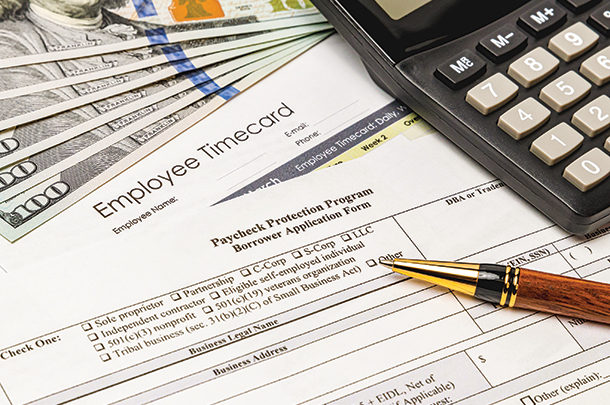The Small Business Administration (SBA) issued two new interim final rules (IFR) on Jan. 7 and for the first time finally addressing Paycheck Protection Program (PPP) loans for farmers and ranchers. This article deals with the first set of IFRs, which concerns the calculation of the first round of PPP loans initiated by the CARES Act. There is both good and bad news in the IFR.
First, the good news. A Schedule F rancher who showed less than $100,000 of net profits on line 34 of Schedule F and had no employees was originally limited to a PPP loan based upon his or her net profits. The Economic Aid Act signed into law on Dec. 27, 2020, changed the calculation from using line 34 net profits to using line 9 gross income with certain modifications if you have employees.
If the ranch had no employees, then you simply look at line 9. If line 9 is greater than $100,000, then you will qualify for the full $20,833 allowed maximum PPP loan based on earnings. If you received a PPP loan less than this amount, you may request a recalculation of the loan based upon gross income with the original lender and will receive an increased loan amount. Any gains reported on Form 4797 from selling or trading ranch assets are ignored.
Example
Sue Smith showed Schedule F net profits of $13,200 on her 2019 return, which was used to obtain a PPP loan of $2,750. Her gross income reported on line 9 was $895,000. She can now reapply with her lender to increase the loan to $20,833 since line 9 is greater than $100,000.
If the Schedule F rancher has employees, it gets a little more complicated. The maximum loan amount is determined by adding the following bullet points:
- Self-employment (SE) income: The amount of gross income on line 9 minus the sum of line 15 employee benefits, line 22 labor, line 23 pension and profit-sharing plans, and line 37. We think line 37 is in error since that line refers to gross receipts, assuming the rancher is on the accrual basis. The line likely should be line 29 taxes and only the amount of state unemployment taxes (SUTA) on those employee wages. They will need to fix this. If this amount is greater than $100,000, it is limited to $100,000.
- Employee payroll costs: Based on 2019 or 2020 IRS 941 taxable Medicare wages from each quarter. As you can see, they still don’t understand farmers and ranchers, since a farm does not file Form 941 but rather a Form 943. Now, the bad news is: They are referring specifically to Medicare wages, therefore commodity wages will not qualify for a PPP loan based on this IFR. Many farmers and ranchers originally received a PPP loan using commodity wages; therefore, when applying for forgiveness, these wages may not be allowed for forgiveness and the producer will have to pay it back.
- Other “employee payroll costs”: 2019 or 2020 employee group health, life, disability, vision and dental insurance, employer contributions for employee retirement contributions, and state and local taxes assessed on the employer (almost exclusively state unemployment taxes).
You divide the totals by 12 and multiply by 2.5 to arrive at the amount of loan you can receive. If your original loan was less than this amount, you can ask for your lender to recalculate and receive an increase. If you included commodity wages in your first PPP loan, then you may have to repay that part of the PPP loan.
Example
Assume Sue Smith also paid her employees $50,000 of cash wages and $50,000 of commodity wages in 2019. The SUTA taxes on the cash wages was $1,500, and Sue did not make any group insurance or retirement plan payments. Her SE earnings is $895,000 minus $100,000 minus $1,500 (we assume you still include the commodity wages in this calculation), which equals $793,500, which is greater than $100,000, therefore final SE earnings is $100,000. She adds in the cash wages of $50,000 and SUTA tax of $1,500 to arrive at $151,500.
Her allowed PPP loan amount is $31,562. She originally received a PPP loan of $23,895 ($2,750 for her earnings plus $21,145 for payroll costs including commodity wages). She can have the lender increase the loan to $31,562 or an increase of $7,667.
Example
Let’s assume that Sue only paid commodity wages in 2019. In this case, her loan is limited to $20,833 (her SE earnings) and, when she applies for forgiveness, she will still owe $3,062 (assuming that commodity wages are not allowed).
The bottom line is: SBA has provided guidance but still leaves some holes for us to figure out. Please feel free to reach out to me at Brandt Self or (817) 882-2244 and follow our blog at CLA Agribusiness Blog for additional guidance.
The information contained herein is general in nature and is not intended, and should not be construed, as legal, accounting, [investment] or tax advice or opinion provided by CliftonLarsonAllen LLP to the reader. The reader also is cautioned that this material may not be applicable to, or suitable for, the reader’s specific circumstances or needs, and may require consideration of non-tax and other tax factors if any action is to be contemplated. The reader should contact his or her CliftonLarsonAllen LLP or other tax professional prior to taking any action based upon this information. CliftonLarsonAllen LLP assumes no obligation to inform the reader of any changes in tax laws or other factors that could affect the information contained herein.









